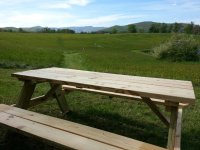Folks,
I have designed a firing range for my 150 acre farm that utilizes a large hill as a backstop. The challenge/concern that I'm facing is that while the hillside projects up about 50 feet from the point of impact behind the targets, the slope is only about 25 degrees or so. So while there is absolutely no question that my rounds will impact the hillside I see the distinct possibility of a round "skipping" off the hard ground and heading up over the hill. I have fired rounds at woodchucks in this field previously and have seen instances where I couldn't find the round at the impact point, it appeared to have "skipped". The nearest house is about a mile away downrange, but I still find this concerning. I don't want any bullet fragments leaving my impact point at all if I can help it.
The second aspect is that I prefer not to dig up a large berm on the hillside if I can avoid it because I use it as a source for hay and drive tractors in it quite frequently. Plus it would be a bit of an eyesore.
I was considering using two large round bales immediately behind the ground impact points to catch any skipped bullets or bullet fragments. I don't believe even a large round bale would stop a rifle round, but I DO think it would easily stop a bullet fragment or even a malformed FMJ round that's already plowed through 12" of hard ground or so.
Thoughts on this? Advice? Obviously safety is of paramount importance in all of this.
-Jeff
Updated: Added a photo of the range from the firing point. You can see two target frames at 50 and 100 yards. There is another at 25 yards, 150 yards, 200 yards, and 400 yards.
I have designed a firing range for my 150 acre farm that utilizes a large hill as a backstop. The challenge/concern that I'm facing is that while the hillside projects up about 50 feet from the point of impact behind the targets, the slope is only about 25 degrees or so. So while there is absolutely no question that my rounds will impact the hillside I see the distinct possibility of a round "skipping" off the hard ground and heading up over the hill. I have fired rounds at woodchucks in this field previously and have seen instances where I couldn't find the round at the impact point, it appeared to have "skipped". The nearest house is about a mile away downrange, but I still find this concerning. I don't want any bullet fragments leaving my impact point at all if I can help it.
The second aspect is that I prefer not to dig up a large berm on the hillside if I can avoid it because I use it as a source for hay and drive tractors in it quite frequently. Plus it would be a bit of an eyesore.
I was considering using two large round bales immediately behind the ground impact points to catch any skipped bullets or bullet fragments. I don't believe even a large round bale would stop a rifle round, but I DO think it would easily stop a bullet fragment or even a malformed FMJ round that's already plowed through 12" of hard ground or so.
Thoughts on this? Advice? Obviously safety is of paramount importance in all of this.
-Jeff
Updated: Added a photo of the range from the firing point. You can see two target frames at 50 and 100 yards. There is another at 25 yards, 150 yards, 200 yards, and 400 yards.
Attachments
Last edited:

